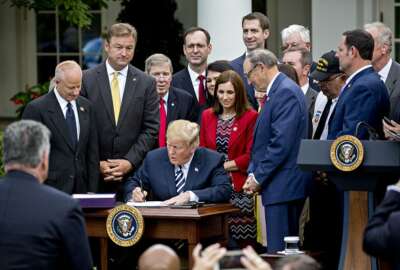

The Department of Veterans Affairs is confident it's ready to implement a major piece of the VA MISSION Act by the June 6 deadline. But another part of the new law...
Best listening experience is on Chrome, Firefox or Safari. Subscribe to Federal Drive’s daily audio interviews on Apple Podcasts or PodcastOne.
The Department of Veterans Affairs said late last week it’s ready to implement a big piece of the VA MISSION Act on time and without major mishaps.
Under the MISSION Act’s new criteria, set to kick off on June 6, roughly 40% of the VA population will be eligible now to see a doctor within the community — as opposed to the 8%
of veterans who can use the department’s disparate community care programs now.
Under VA’s new access standards, veterans can see a community provider if they’ve been waiting for more than 20 days for primary, mental health and non-institutional extended care services, or if they face a 30-minute drive to the nearest VA facility.
Average drive and wait times tick up to 60 minutes and 28 days for certain kinds of specialty care under VA’s proposed regulations.
The previous legislation, the Veterans Choice, Accountability and Transparency Act of 2014, allowed veterans to visit a community provider if they lived 40 miles away from the closest VA medical facility or if they had been waiting 30 days or longer for VA care.
Still, the department believes veterans will continue to use VA care. VA officials said they estimate roughly one-third of enrolled veterans would seek community care, even under the MISSION Act’s new criteria.
“The majority of our population does have eligibility for another health care system, like Medicare or Medicaid,” a VA official said. “Many veterans do balance their reliance between those systems. We do expect reliance on VA to increase, both in our direct system and in community care.”
Veterans themselves won’t see much of a visible change, VA officials said, and June 6 will be “just another day” in the department’s health care system.
“We are working diligently to train our relevant staff both in the central office and in the field,” a senior VA official told reporters last week. “We will deliver care on June 6, and we look forward to continuing to evolve and enhance the system as we move past that date.”
The department itself will experience most of the VA MISSION Act changes on the back-end, as it continues to develop the IT systems, such as the decision support tool, that will administer the law’s new regulatory changes.
The department has set up a joint operations center to field emerging needs that arise during MISSION Act implementation, VA officials told reporters. More improvements to the community care program will come later this summer.
VA will also begin new contracts for third party administrators based on geographic regions starting in June, though the department’s existing contractor, the TriWest Healthcare Alliance, will continue service until contracts for all six regions begin on a rolling basis.
But another piece of the VA MISSION Act has been delayed. As part of the MISSION Act, Congress instructed VA to expand the Program of Comprehensive Assistance for Family Caregivers to veterans of all eras.
The program was first limited to veterans who were severely injured on or after Sept. 11, 2001, but the VA MISSION Act, which Congress passed last summer, expanded coverage to include veterans of all eras.
The department estimates the caregivers program could have as many as 60,000-to-100,000 veterans with the eventual expansion.
But pre-9/11 veterans can’t apply for the caregivers program until VA implements and certifies a new IT system to manage the program. According to the MISSION Act, VA was supposed to implement a new IT system by October 2018 and certify that system to Congress this October.
The department has missed the first deadline and will likely miss the second, VA confirmed to the House Veterans Affairs Health and Technology Modernization subcommittees last week.
“We do not have a definite date yet,” Alan Constantian, VA’s deputy chief information officer for account management, told the subcommittees at a hearing on the caregiver program last week. “We’re waiting for the determination on when the IT system will be fully operational.”
Development of the new IT system for the caregiver program, called the Caregiver Records Management Application (CRMA), will occur in phases. VA used a blanket purchase agreement to contract with Salesforce to develop much of CRMA.
The new system will manage caregiver applications, administer the comprehensive assistance program, track calls to caregiver support line and process payments, said Steven Lieberman, acting principal deputy undersecretary for health at the Veterans Health Administration.
VA first plans to replace the capabilities of its old caregiver tracking system by October. The department will develop a stipend processing capability in the second phase of the project, due in January 2020. The third phase will put caregiver applications online and will ensure the program is ready for expansion, Constantian said.
The original IT system, called the Caregiver Application Tracker (CAT) was designed to handle some 5,000 caregiver records. Today, VA’s caregiver program has roughly 20,000 records.
The Government Accountability Office assessed the CAT system back in 2014 and suggested VA find another IT solution.
“It’s deeply frustrating that after the GAO report these IT problems persist,” said Rep. Julia Brownley (D-Calif.), chairman of the VA Health Subcommittee. “It is even more frustrating that the only thing standing between pre-9/11 veterans and their caregivers and the services they need is this IT program.”
VA began CAT-Rescue soon after GAO’s assessment. When the rescue failed, VA began a third attempt, called the Caregiver Tool (Care-T). After three years and more than $7 million, VA scrapped the third attempt. One of its contractors, AbleVets, said it had delivered much of the VA’s requirements for Care-T by the time the department scrapped the project earlier this year.
Now that VA is on its fourth attempt, lawmakers on both sides of the aisle are frustrated.
“We specifically put in law that we would not go live with this program until you all, the experts, could certify the IT program,” Phil Roe (R-Tenn.), ranking member of the House VA Committee, said. “That holdup of the IT is keeping a lot of World War II vets, Korean War vets … [and] elderly people that desperately do need this [from using this program].”
Rep. Susie Lee (D-Nev.), chairman of the VA technology modernization subcommittee, said VA’s current challenges with the caregiver IT system resemble those it’s experiencing in developing a system to handle regulatory changes under the Forever GI bill — and its efforts to move to a new electronic health record that’s interoperable with the Defense Department.
“Time and again we sit here and discuss failure,” she said. “We are assured that lessons have been learned and that things would get fixed, and here we are one more time. At what point will the VA fix the systematic problems on how it buys, implements and manages IT? When is the VA going to commit to getting it right and not make the same mistakes with weak governance, inadequate program management and poor requirements development?”
VA has designated a full time product manager for the caregiver IT system, and it’s using an agile development process to build the new CRMA system, the department said.
The decision to incrementally develop the new system is a good start, GAO said, but the agile methodology is still relatively new for VA . The department has the skills and in-house talent it needs to use agile development.
“They have historically developed their systems in house,” Carol Harris, director for IT acquisition management at GAO, said. “That’s a completely different animal from acquiring a commercial product and utilizing agile development processes to do so in the configuration as well as the customization of the ultimate solution.”
Copyright © 2025 Federal News Network. All rights reserved. This website is not intended for users located within the European Economic Area.
Nicole Ogrysko is a reporter for Federal News Network focusing on the federal workforce and federal pay and benefits.
Follow @nogryskoWFED



